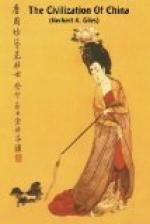Meanwhile, a high state of civilization was enjoyed by these feudal peoples, when not engaged in cutting each other’s throats. They lived in thatched houses constructed of rammed earth and plaster, with beaten floors on which dry grass was strewn as carpet. Originally accustomed to sit on mats, they introduced chairs and tables at an early date; they drank an ardent spirit with their carefully cooked food, and wore robes of silk. Ballads were sung, and dances were performed, on ceremonial and festive occasions; hunting and fishing and agriculture were occupations for the men, while the women employed themselves in spinning and weaving. There were casters of bronze vessels, and workers in gold, silver, and iron; jade and other stones were cut and polished for ornaments. The written language was already highly developed, being much the same as we now find it. Indeed, the chief difference lies in the form of the characters, just as an old English text differs in form from a text of the present day. What we may call the syntax of the language has remained very much the same; and phrases from the old ballads of three thousand years ago, which have passed into the colloquial, are still readily understood, though of course pronounced according to the requirements of modern speech. We can no more say how Confucius (551-479 B.C.) pronounced Chinese, than we can say how Miltiades pronounced Greek when addressing his soldiers before the battle of Marathon (490 B.C.). The “books” which were read in ancient China consisted of thin slips of wood or bamboo, on which the characters were written by means of a pencil of wood or bamboo, slightly frayed at the end, so as to pick up a coloured liquid and transfer it to the tablets as required. Until recently, it was thought that the Chinese scratched their words on tablets of bamboo with a knife, but now we know that the knife was only used for scratching out, when a character was wrongly written.
The art of healing was practised among the Chinese in their pre-historic times, but the earliest efforts of a methodical character, of which we have any written record, belong to the period with which we are now dealing. There is indeed a work, entitled “Plain Questions,” which is attributed to a legendary emperor of the Golden Age, who interrogates one of his ministers on the cause and cure of all kinds of diseases; as might be expected, it is not of any real value, nor can its date be carried back beyond a few centuries B.C.
Physicians of the feudal age classified diseases under the four seasons of the year: headaches and neuralgic affections under spring, skin diseases of all kinds under summer, fevers and agues under autumn, and bronchial and pulmonary complaints under winter. They treated the various complaints that fell under these headings by suitable doses of one or more ingredients taken from the five classes of drugs, derived from herbs, trees, living creatures, minerals, and grains,




